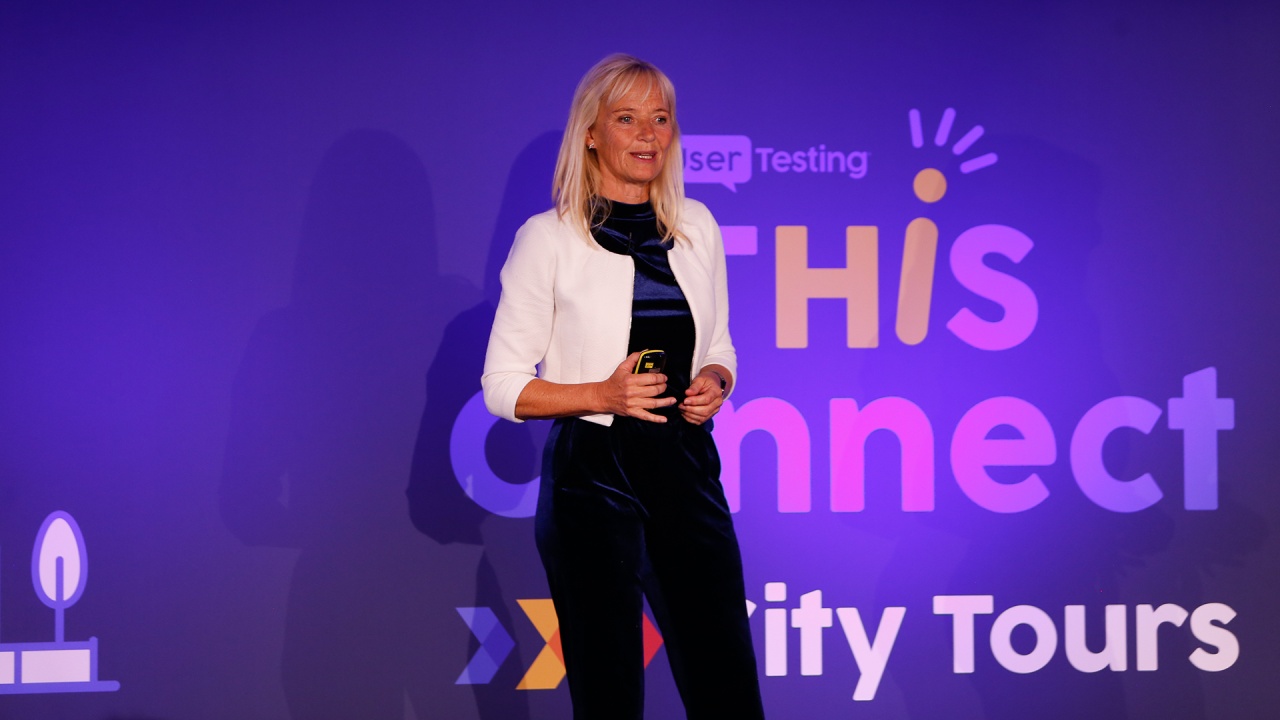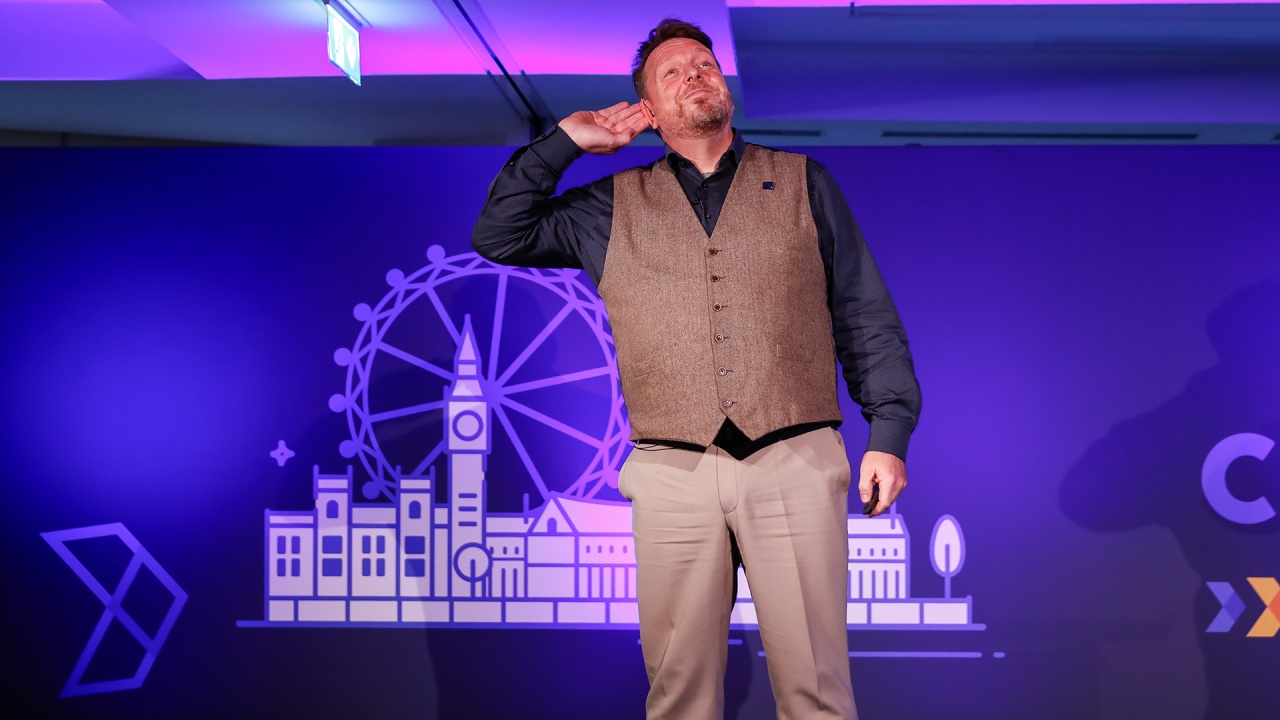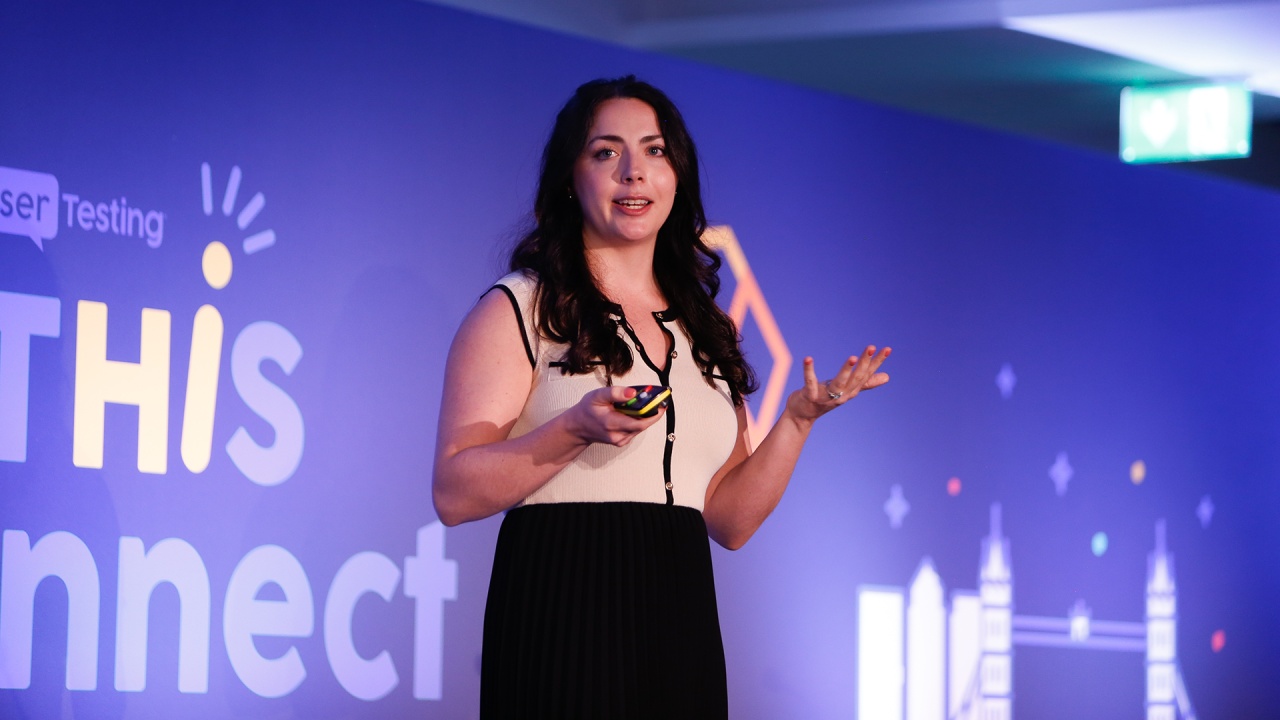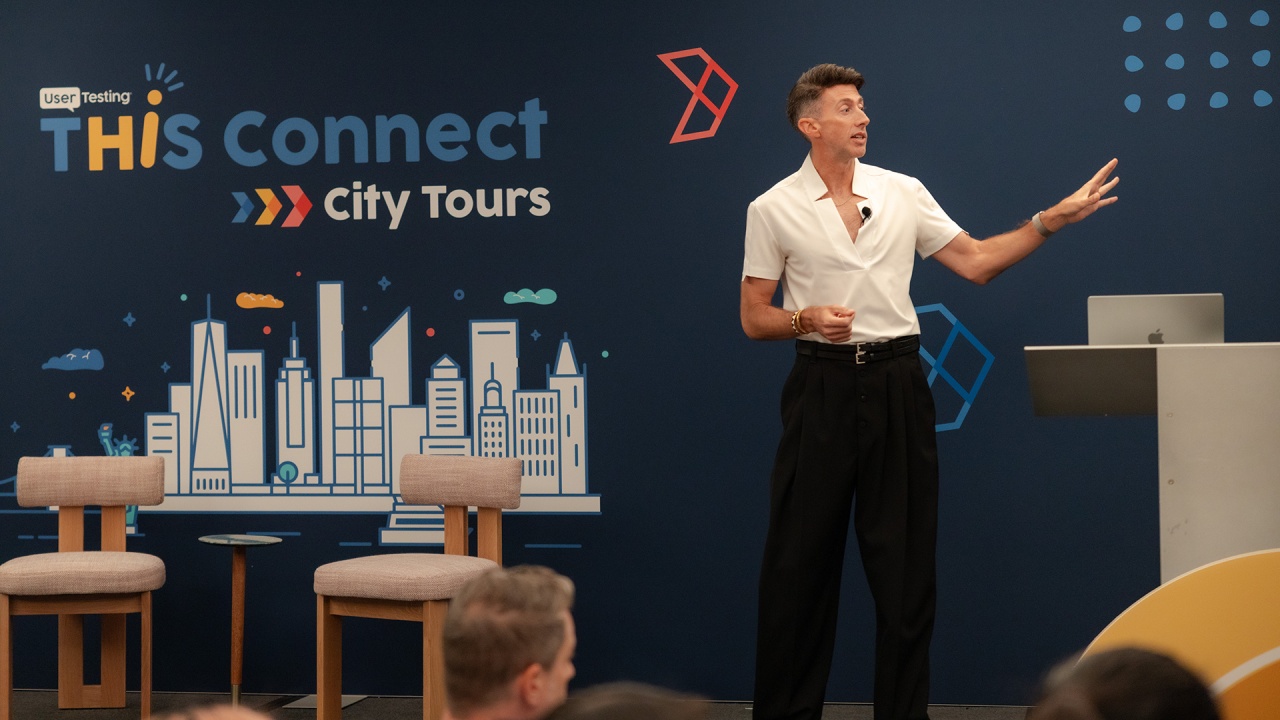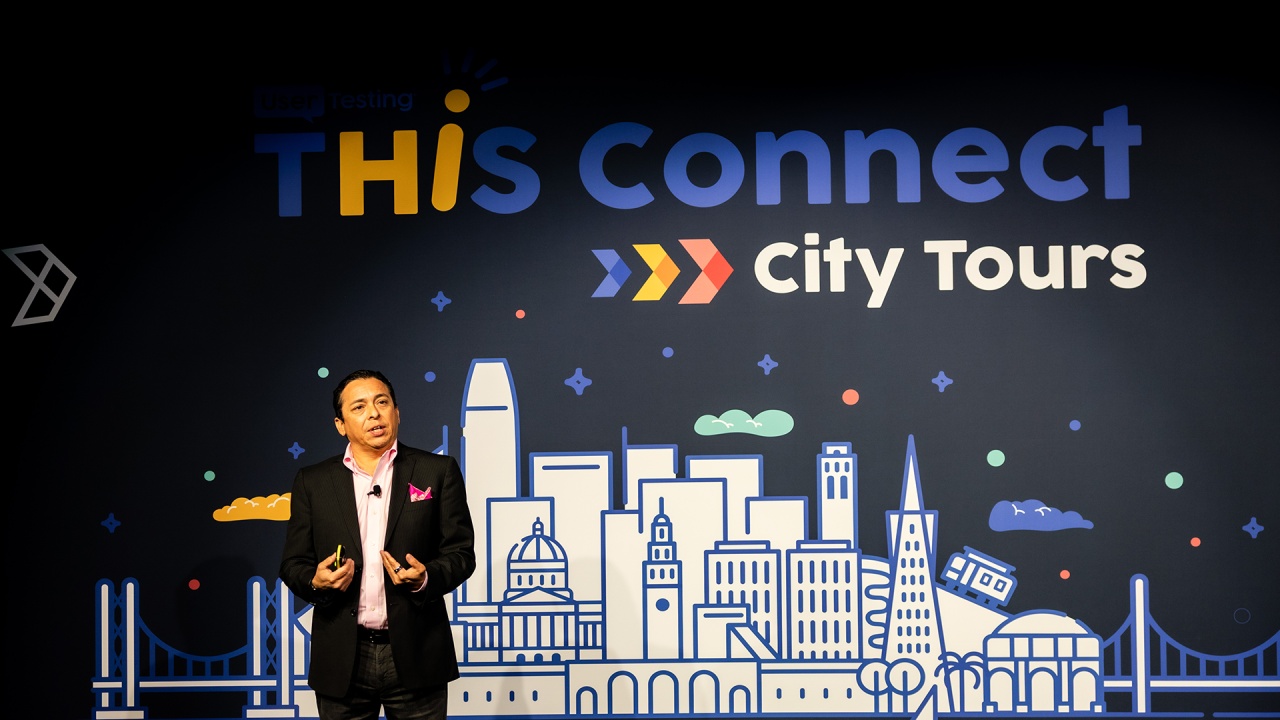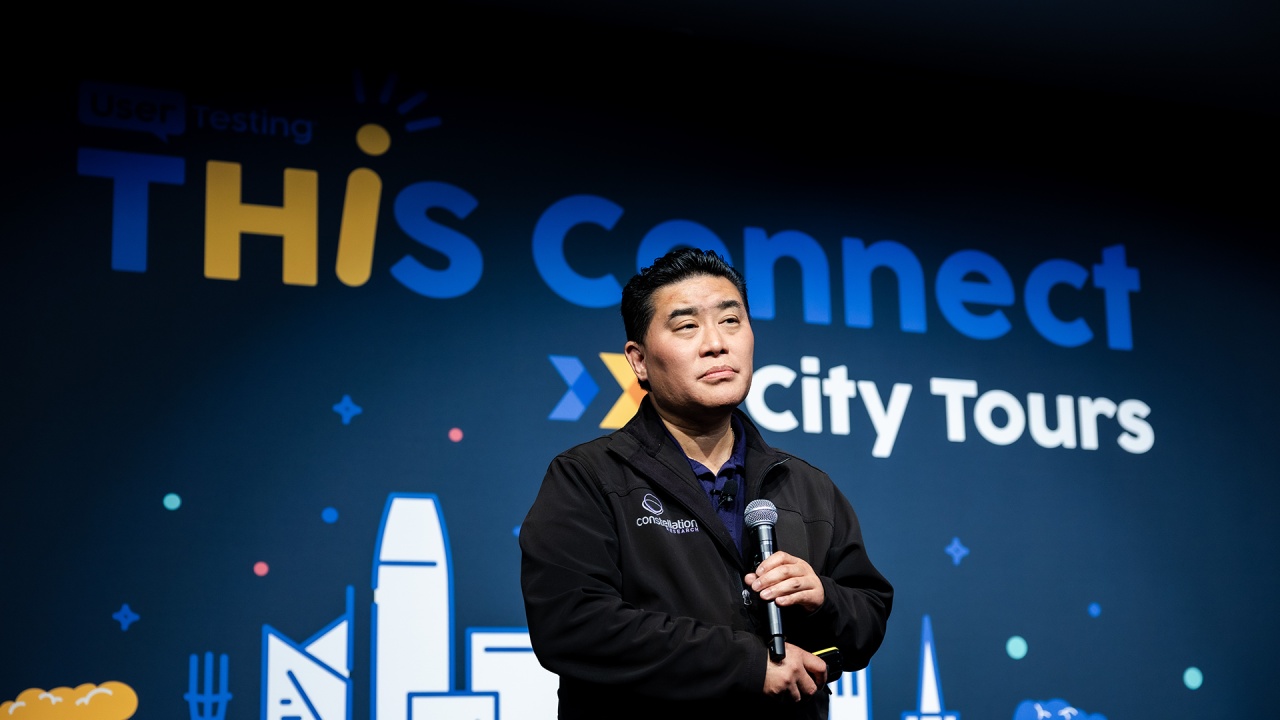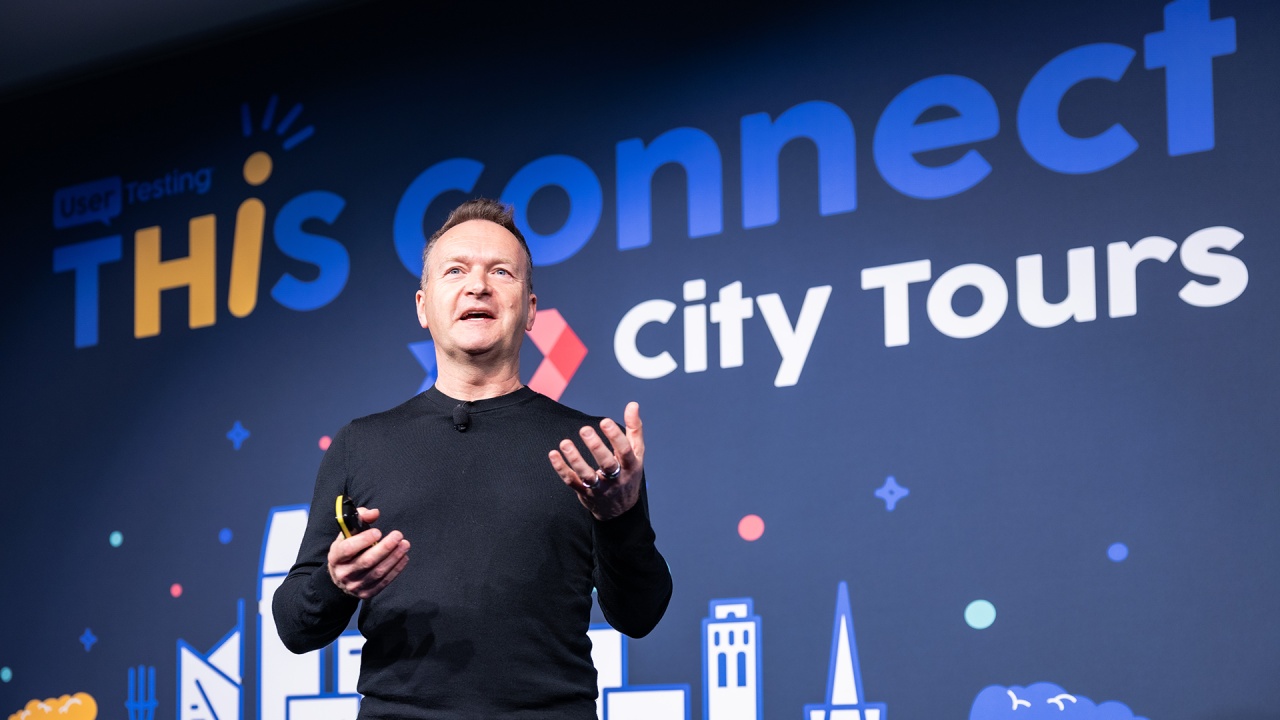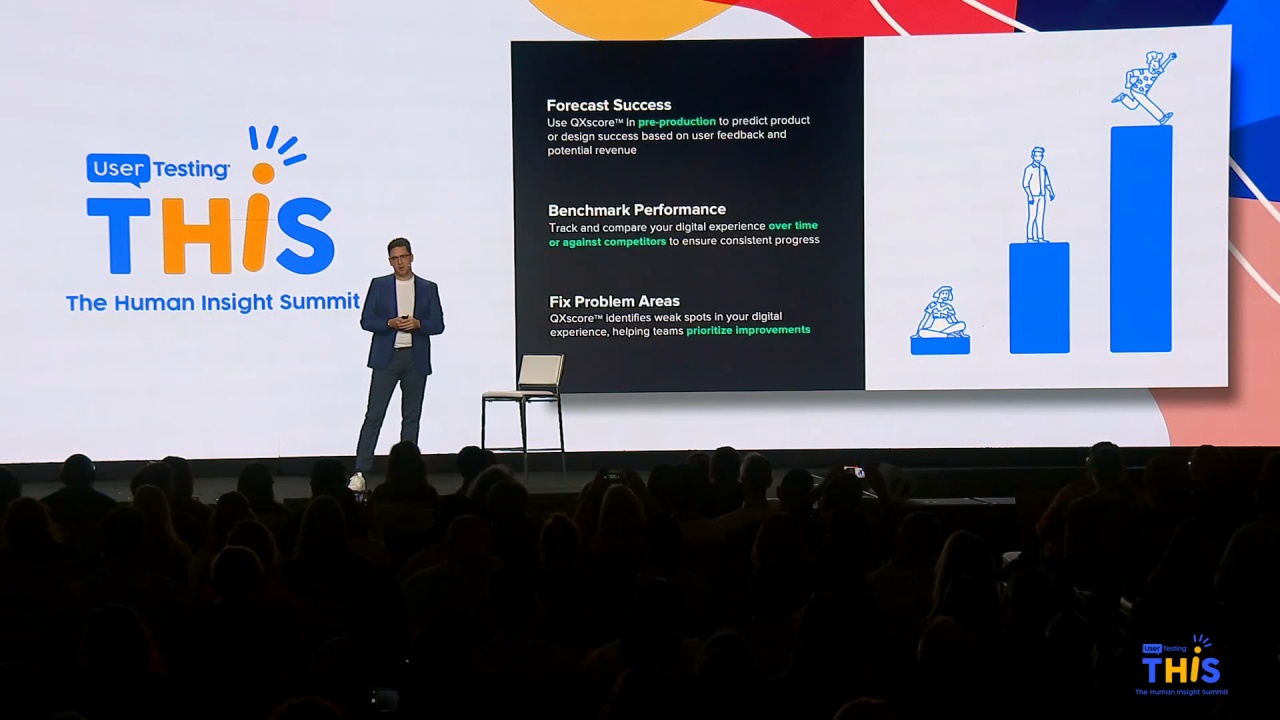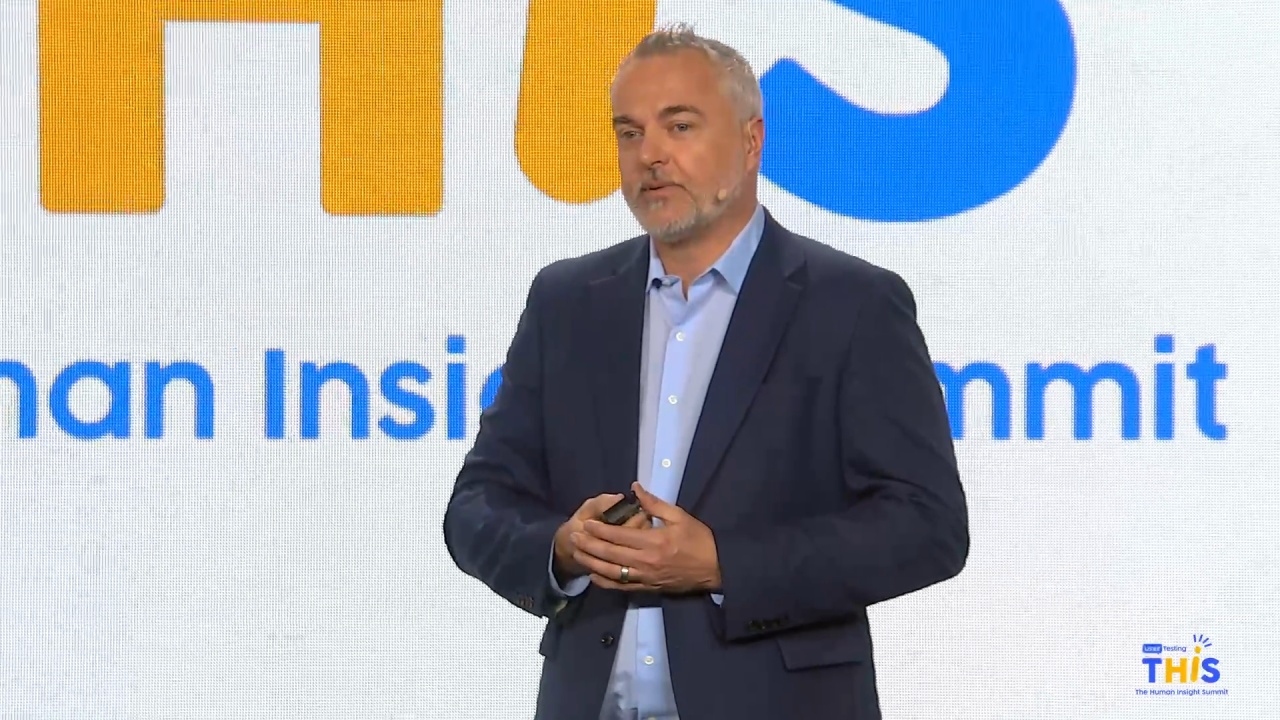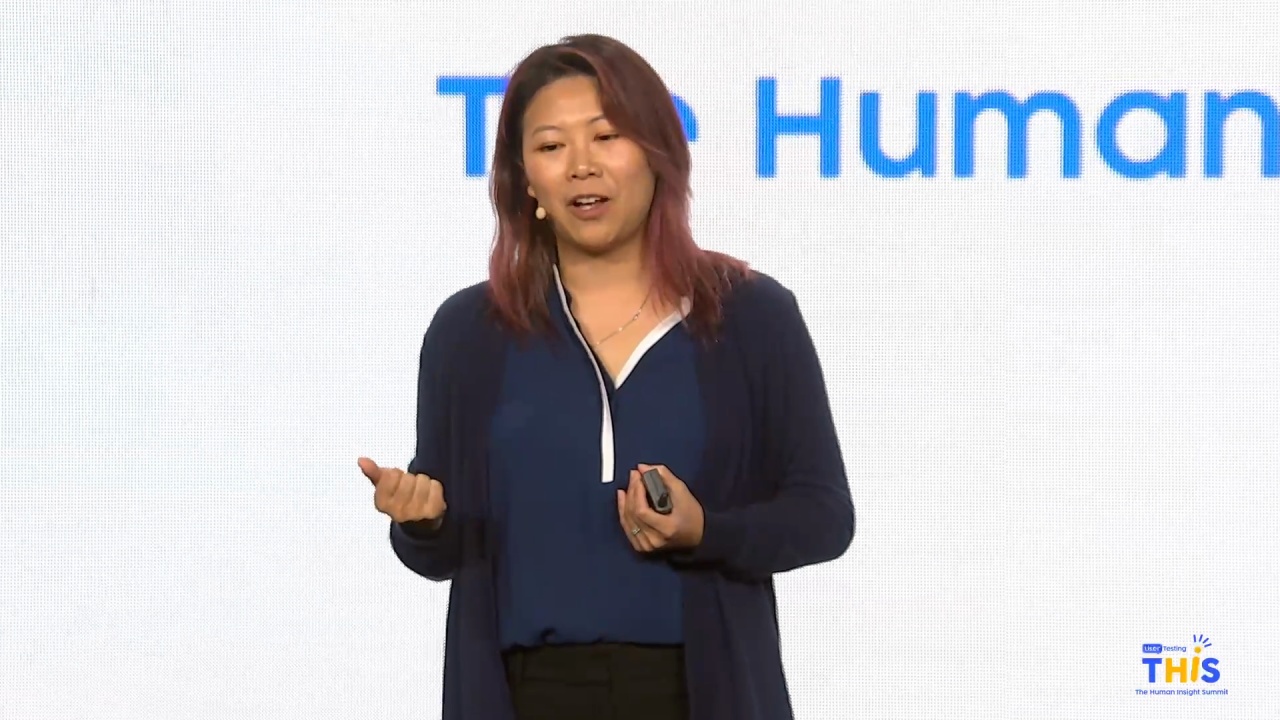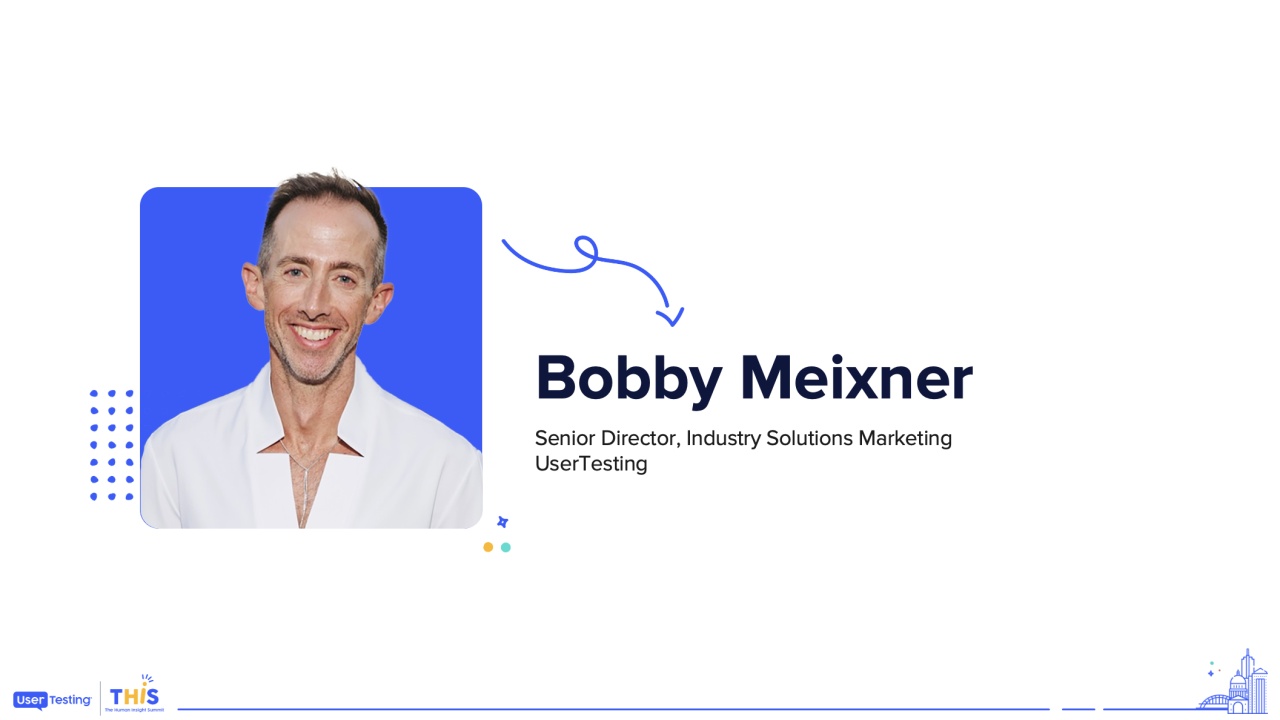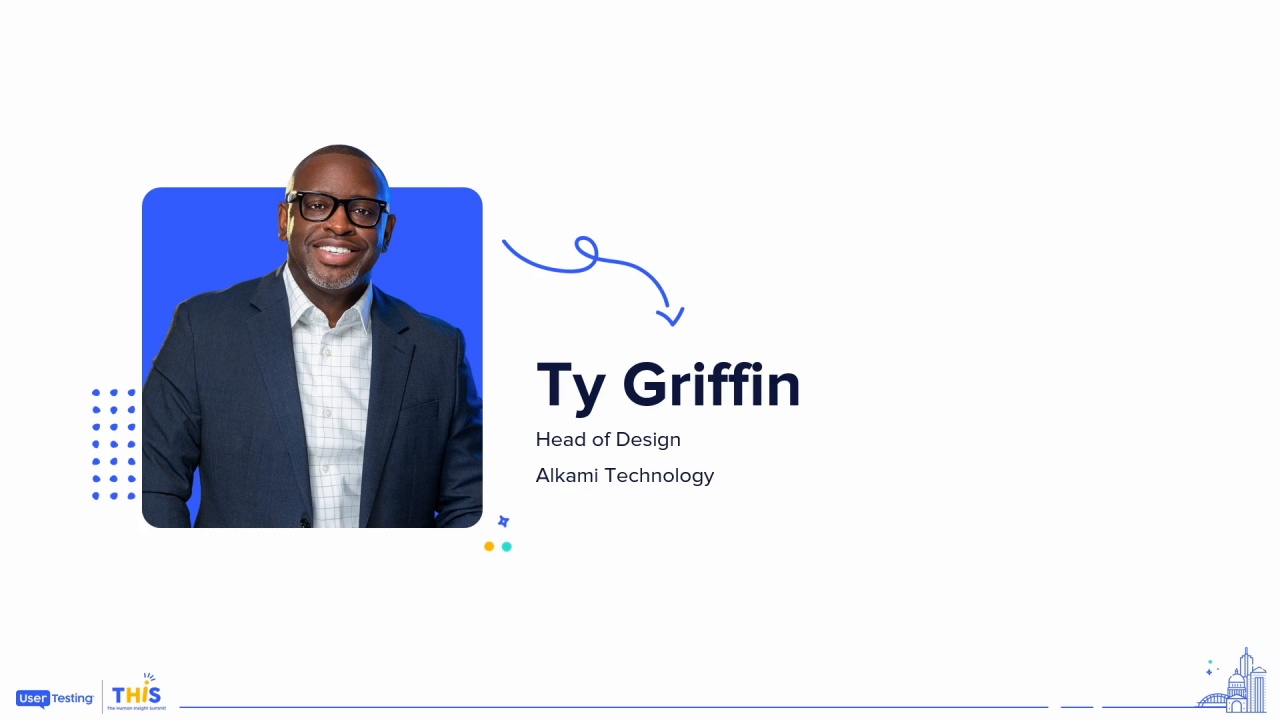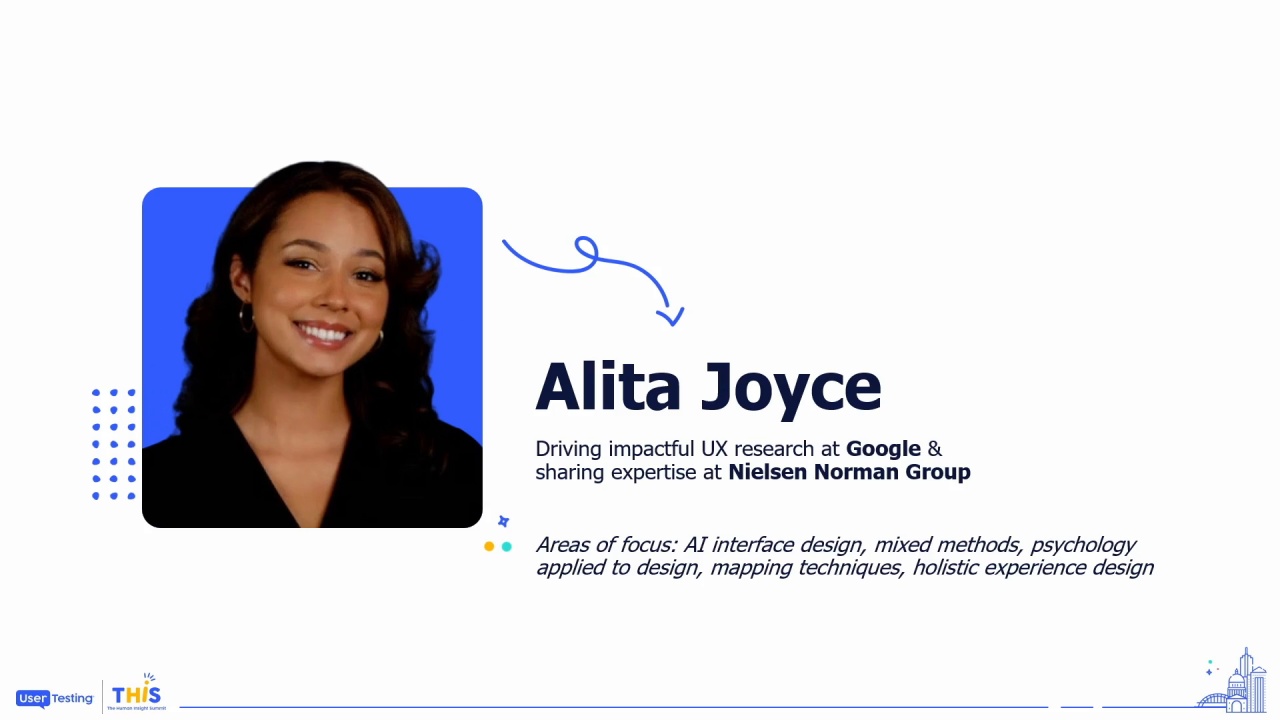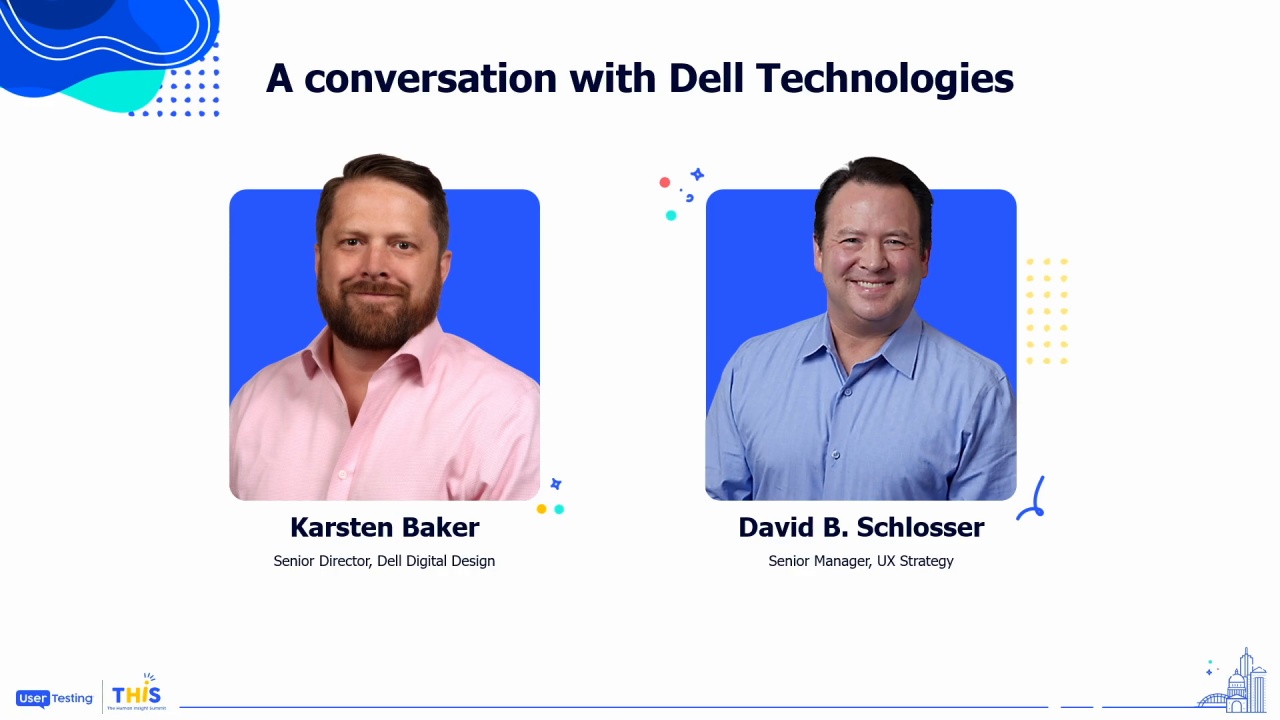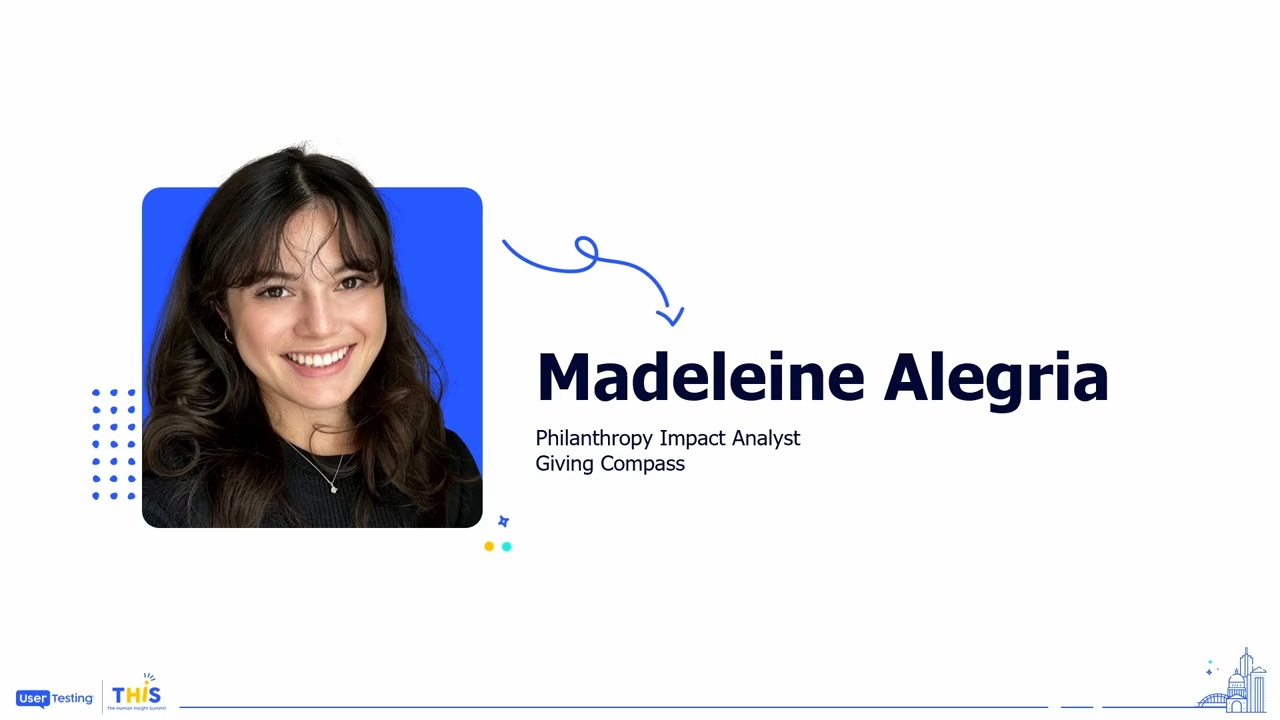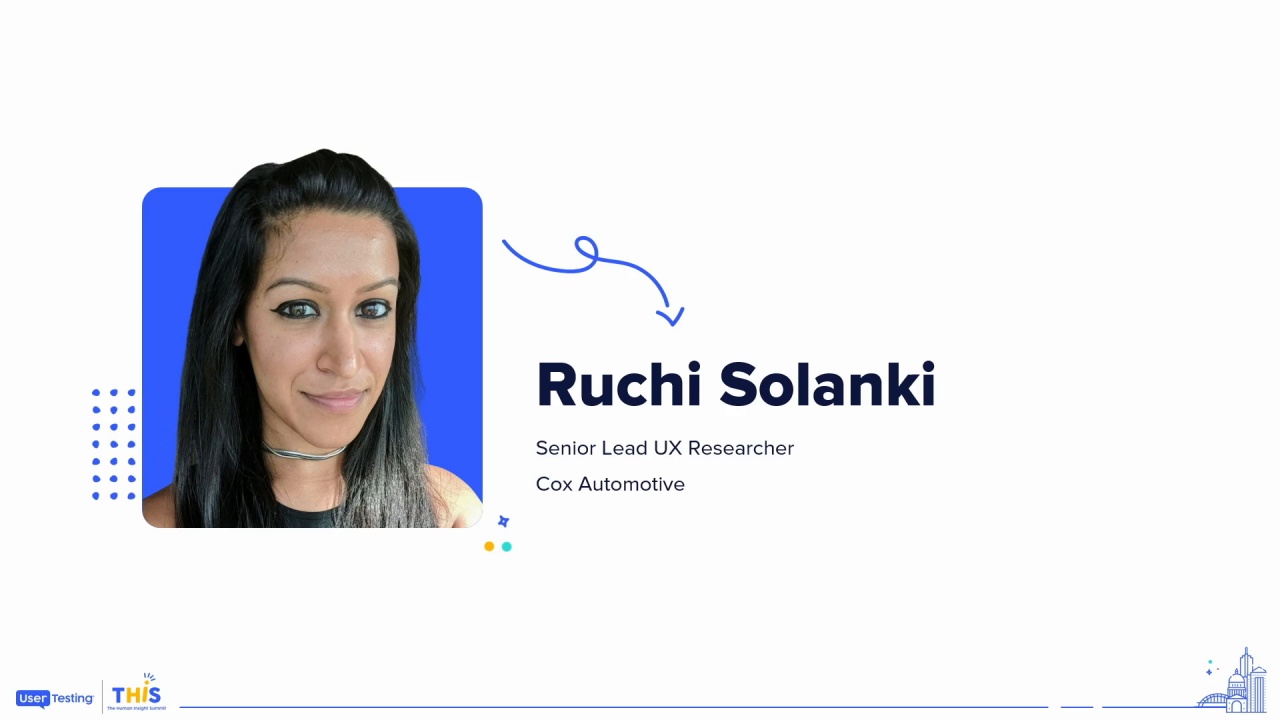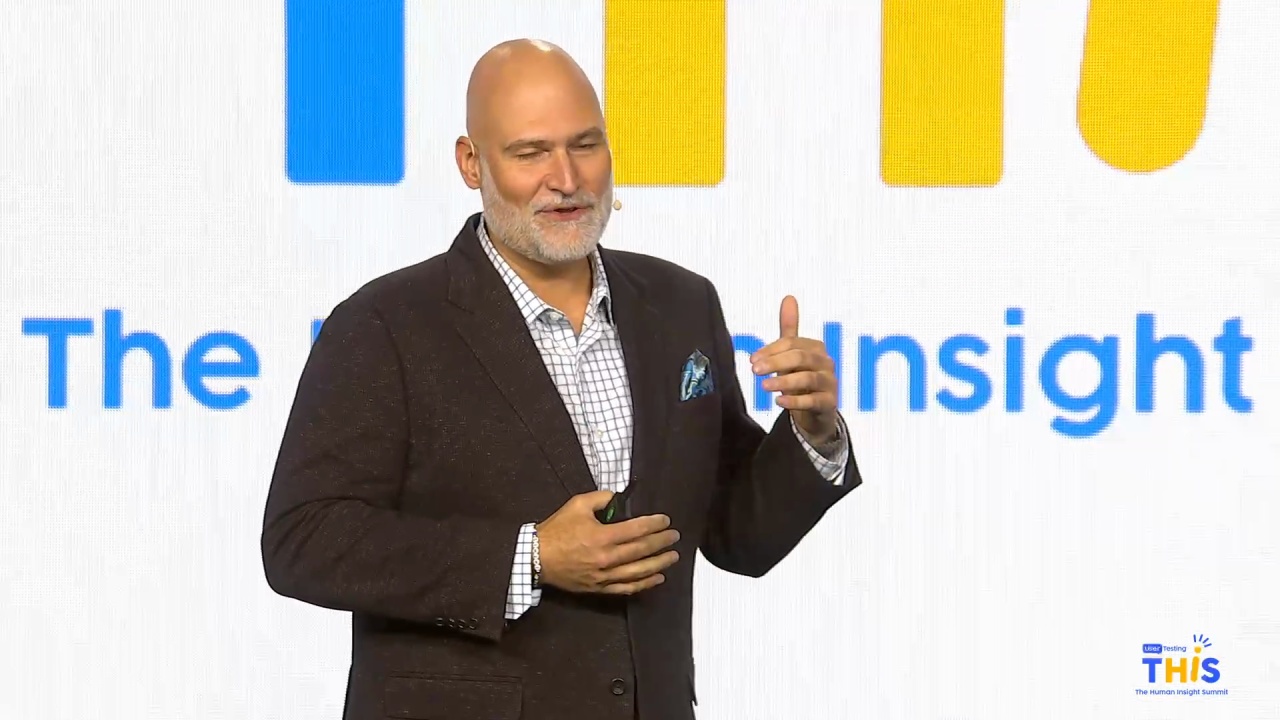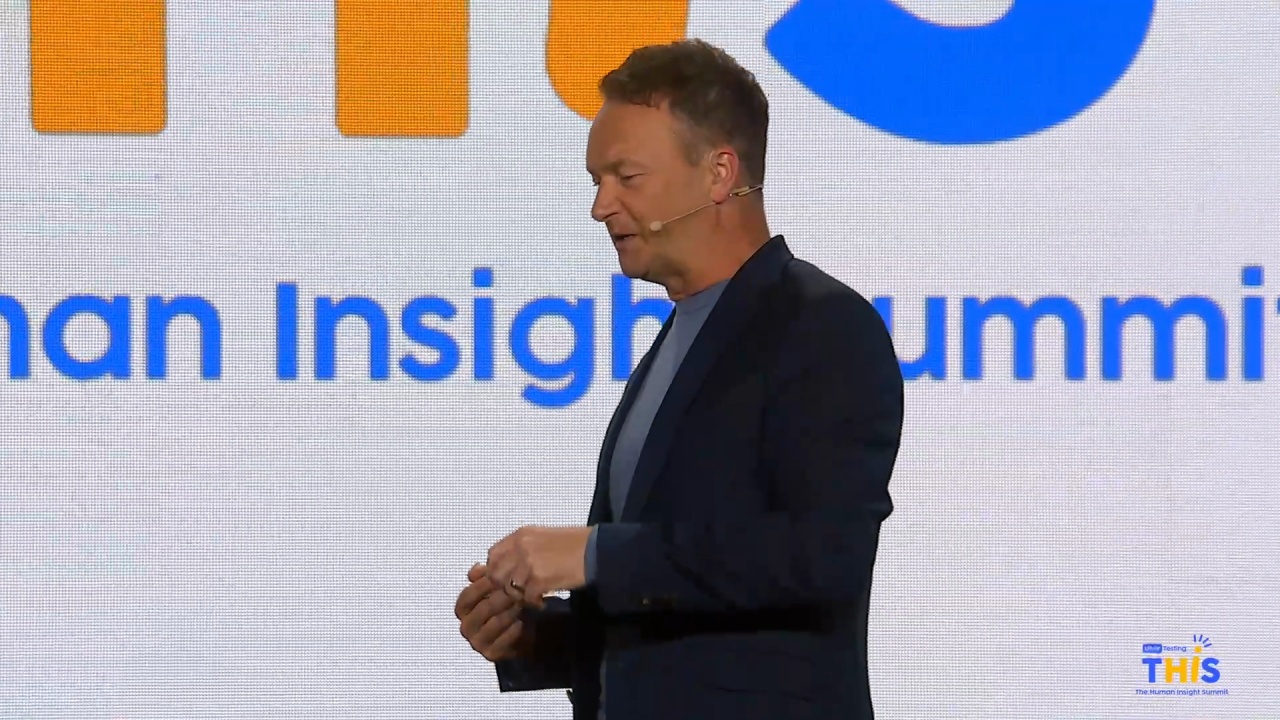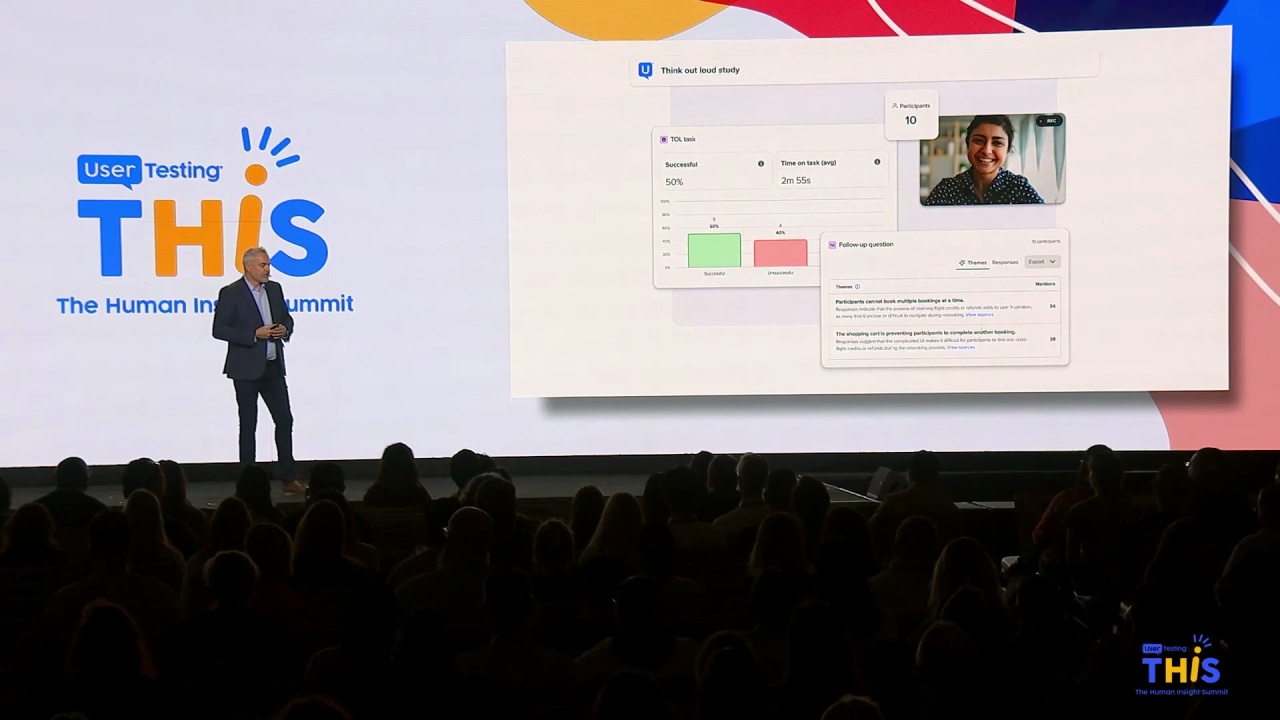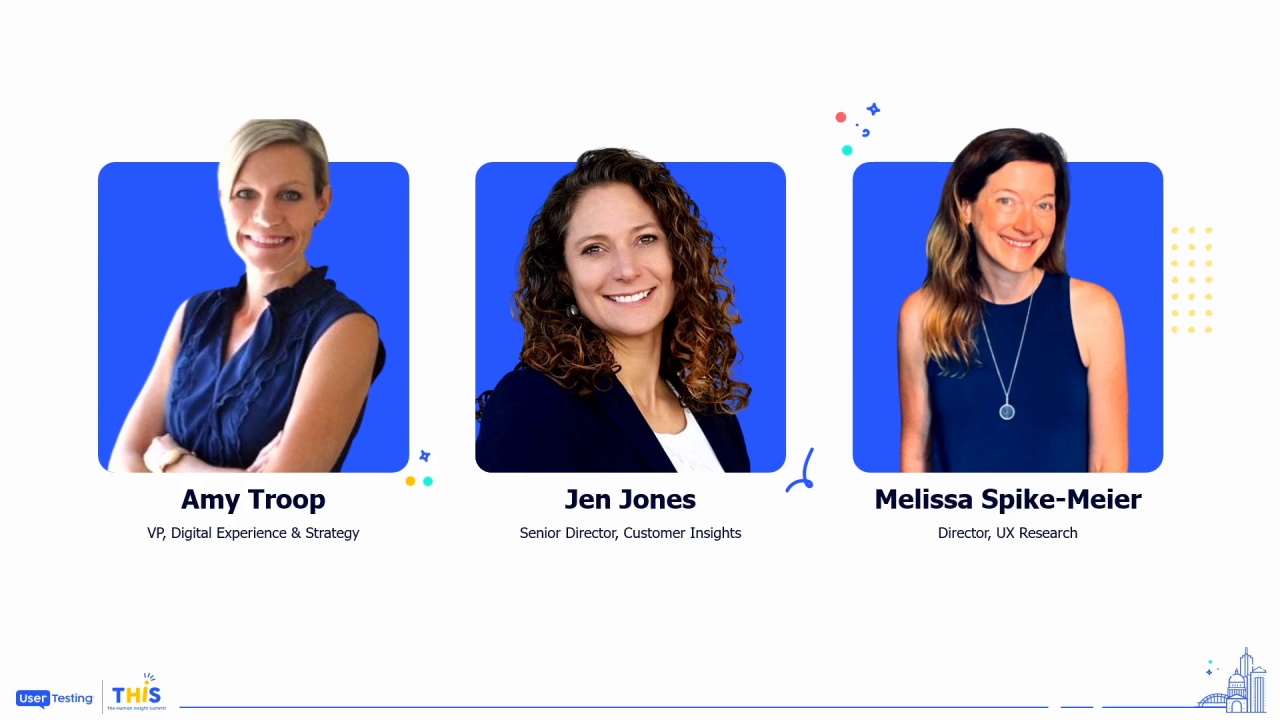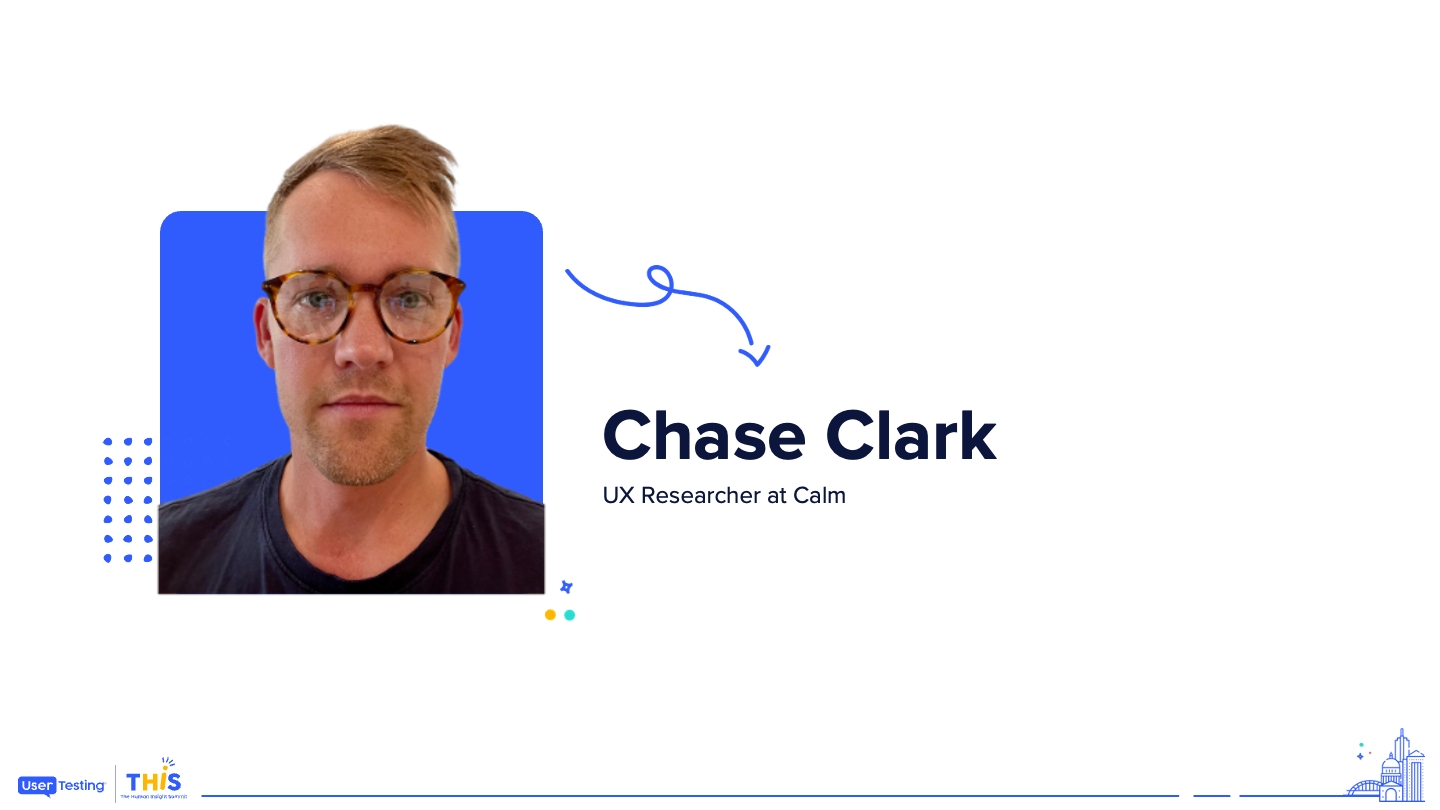
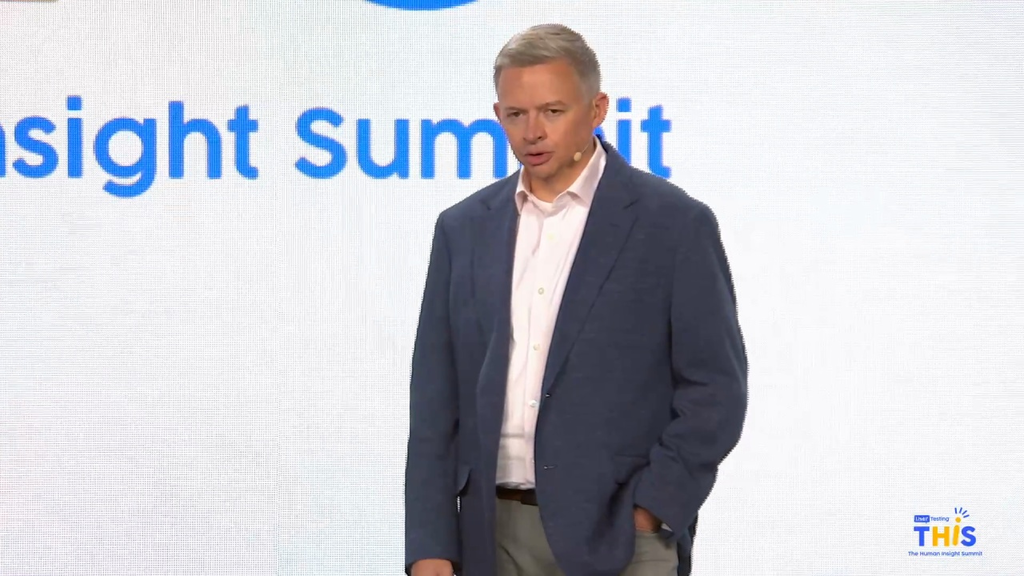
THiS 2024: Opening keynote - A vision for the future
Eric Johnson
Chief Executive Officer, UserTesting
Johann Wrede
Chief Marketing Officer, UserTesting
Caleb Schmidt
Head of Experience Design, US Bank
Michelle Engle
Chief Product Officer, UserTesting
Join us for an inspiring keynote on how leading companies leverage UserTesting to stay ahead in a competitive landscape and deliver exceptional customer experiences. Hear industry leaders share how co-creating with their customers has transformed their business and fueled recent innovations.
User testing is the platform that connects the human heart to the human mind.
In today's world, every interaction matters and great customer experiences set companies apart. To create moments that truly connect, we need to understand the people behind each decision.
This is taking a human on a literal customer journey, and being able to talk to humans and talk to customers along the way as we design this experience, whether that's digital or hard product, is critical.
The scale in which we need to make decisions, build out strategies, and plan the direction that our...
User testing is the platform that connects the human heart to the human mind.
In today's world, every interaction matters and great customer experiences set companies apart. To create moments that truly connect, we need to understand the people behind each decision.
This is taking a human on a literal customer journey, and being able to talk to humans and talk to customers along the way as we design this experience, whether that's digital or hard product, is critical.
The scale in which we need to make decisions, build out strategies, and plan the direction that our companies are going in is at a higher velocity than humankind has ever experienced.
Staying ahead isn't just about reacting. It's about being proactive at every step of the customer journey. It's making sure everyone in the organization understands the customer so they can anticipate needs and make smart decisions that improve the experience.
User testing gives us the human insight that we need to ensure that we're truly meeting our customer needs.
Human insights connect data to real understanding, unlocking experiences that go beyond expectations.
Bringing in those human insights, having that qualitative touch really brought to life what our customers are actually like in their real lives, their stories, their lives, how our product would fit into them.
Human insight leads us to build products that are meaningful to users.
These insights lead to better decisions, reduce uncertainty, and create stronger connections with customers, building loyalty and driving growth. Human insight helps us limiting risk by predicting how a customer is gonna interact with our product.
Human insight lets us increase profitability by providing real customer centric solutions that actually work.
With user testing, teams can connect with customers like never before using real human insights to guide every decision.
And we want every single person across the company to feel empowered to use user testing to help steer the decision making in their day to day projects.
By embracing these insights, we're not just improving customer experiences, we're shaping a future where every interaction is meaningful and personal. Together, we can build tomorrow's experiences today.
And now, please welcome the CEO of user testing, Eric Johnson.
Good morning everyone.
Thank you. Thank you very much. I'm blinded, but it does seem like there's a ton of people here so that is great. Thank you very much.
So this is my first Human Insight Summit here in Austin and I can already tell you after a day and a half what an amazing group of people we have in our community and I'm looking forward to meeting as many of you as possible over the next day and a half that we still have ahead of us. Now first a bit about myself since I am new. I'm not even two months into this. I think this coming Monday is my two month personal anniversary as part of user testing.
So briefly, I'm based up in Seattle, Washington.
My wife my wife and I have two kids. We have a seventeen year old son, Luke, who loves basketball, and we have a thirteen year old daughter, Kate, who loves volleyball. If I'm not working on user testing, I usually am in a gym watching one of their games, which is super fun. Now previous to coming here, I was the CEO of a company called Nintex, which is a leader in process intelligence and automation.
I think the important part to know about what we did there, couple things. One, I partnered up on that deal in that company with Thoma Bravo, which is the majority investor here at User Testing.
Now at Nintex, we transformed from a single product, kind of a narrow capability, to a broad platform of capabilities. We invested heavily in customer success, and we went from having kind of a medium customer experience to being number one in our industry.
That focus on customers and driving value and helping everyone succeed is what I love and why I joined user testing.
Now as we move forward together here, where I wanna begin is by saying thank you. First off, we have over five hundred different people here. We have people from customers. We've got partners here. We've got broader people from our community. Thank you all for taking the time to come to Austin and investing in your journey with human insights and user testing.
When we look at the people who are here, we represent together many of the best companies and organizations in the world. If we could have a bigger slide, we'd have over four hundred logos, but we couldn't we couldn't do that. Didn't want it to be too much of an eye chart.
I'd also like to thank our partners who've sponsored this event.
Zilker Trail, who I know is doing session with us, ContentSquare, Rally, and Figma.
Now what are we about as we move forward? Everybody wants to know where we're going. Really critical to us as a team is our mission. So our mission here is to be the world's leading human insights platform for innovators to transform customer experiences.
We are all about how human insights impact customer experiences. So everything we will do the next several years, whether it's internal investments in our product and technology, our services, acquisitions that we may make, they will all fit under this umbrella.
Now the how we work is critical.
Personally, I view values as being one of the most important things that we do in our organization.
Our number one value here that we always start with is to deliver on our commitments.
We make commitments to you. It could be road map. It could be something about the project we do together. We need to deliver.
Number two is don't wait. We might have a challenge together. We might have an opportunity. We wanna seize it. We wanna immediately act on it, and that's our don't wait value.
And number three is to operate with respect and consideration.
I want you all to have a very positive experience as we work together.
Sometimes things don't always go exactly to plan. Wanna make sure as a team that when that happens, we're clear. That's being respectful with our customer or our partner. So together, these are the things that we're gonna make sure we do over the next few years. Now, in terms of what we deliver and how we deliver value, there's five priorities on how we're gonna help you all get to great faster.
Number one area we're focused on. So when we brought the companies together in January of twenty three, user testing and user zoom, we talked about bringing together the best of both. And and one of the things that we think a lot about as a team is, well, what's in it for you? Why why is that good?
And I know on that journey, it wasn't always easy. But what I can say now is the unified platform that you're gonna see today, and you'll see during Michelle Engel, our chief products officer section, you will see how a couple years nearly a couple years of work has come together in a next generation, modern, scalable, enterprise class, highly secure platform for you to do more, bringing the best of both technology sets, plus a lot of new innovation together. That uniform unified platform will be generally available in January. And I know many of you are in the beta, so thank you to those who are.
Now it's important to point out, if you are on user Zoom today, you might not be totally ready really quickly to go to the next generation platform.
We aren't gonna make you go. You take your time, we will have both platforms going for many years to come.
Second, innovation, the enhanced capabilities that we bring to you. So our development teams, one of the great things about moving and getting through this unification project is we now unleash a massive amount of developer capability to bring enhanced capabilities to you. Now we're gonna show some of it this week, so you'll see things like how we're taking AI to make it easier to answer questions in the platform.
You'll also hear about and get to see a little bit of where we're gonna go down the road. So in two thousand twenty five, I know one of the things I get asked about a lot is diary studies. So for example, diary studies will get delivered very, very elegant way to do them in two thousand twenty five.
Integrations are critical. So when I talk with customers even in my first couple months, we talk about where where is it that you do your work? Where do you live? Where are the people that tech touch the technology and deliver human insights?
Where are they working? Well, one place we know tons of our community works in is Figma. And so our team has put a bunch of work into making our integrated experience with Figma much, much richer. And so you'll see that, and that gets released in January.
But it doesn't stop there. There's many other systems that you all work with and we wanna make it easier to get your work done. The easier we make it, the more value you add to your organizations.
Fourth is expanding our participant network. So one of the key value drivers that we give is we have the world's largest, richest network, but we don't stop. We never rest here. And so that network I've talked with many customers who've asked for, hey, could you do more in this international area?
Could you do more in this specific area? So we're investing in a lot more per, participant recruit, so we will have more, more people in the network. We're investing more in our security around it. How do we make sure that we don't have any any fraud going on in there?
And if you're on the user Zoom platform, we're actually connecting up the user testing complete network and capabilities into the platform. So no matter where you are over this next year and beyond, you're gonna see more investment in the participant network.
And finally, one of the questions I get asked, especially when I'm with large organizations, bigger and more complex use cases, wanting to use us more widely, we get a request for, hey, could you help me? You know, you know what people do in banking. You know what people do in travel. Could you help us with these use cases?
Could you bring this advice to us? And so we're investing more in our solution oriented services. And I wanna be clear, it's not only our services, it's also services from our partners. So one of our partners, Zilker, is here speaking.
We have other partners, and we'll continue to invest in both our own services and our partner services so you get the expert advice that you need so you can deliver value.
One of the other things I think a lot about, and and we've talked to as many of you as I've gotten to know people, is that you're doing great work for your organizations.
One of the things I think we can do together even better is to highlight that work. And so one of my ask is as we work together and, for example, I come out in the field and other members of our leadership team, help us see the senior people in your organization who own the most important projects.
Together, I know we can do such great good because I've seen it.
At this point, I would love to turn it over to Johan Reed, our chief marketing officer, who's gonna talk about how human insights impact the entire customer journey. Johan.
Thank you, Eric.
Keep that one. Good morning. Hello, everybody.
Alright. So are we enjoying the experience so far? Alright.
I hear some people are enjoying the coffee. I got more applause over there.
As Eric said, I'm Johan Reed, and, I'm the I'm the new chief marketing officer here at UserTesting.
I'm new to User Testing. I've been here. This is my fifth week, but I'm not new to the customer experience. In fact, I've spent most of my career in and around customer experience.
This book was written in nineteen ninety nine. Is it can I get a show of hands? Do you all know this book? Have you seen this book? I'm seeing some hands. Yeah. So I think this actually this was written in nineteen ninety eight and it's about at the time, it was about the fact that people were shifting from buying things and valuing things to looking for experiences.
So we were seeing this transition from buying material stuff to valuing concerts and travel, and the economy was changing. And so my CX journey sort of grew up in this experience economy where when I looked around me, I was watching people go from spending ninety nine cents for a cup of coffee to six dollars for a cup of coffee, not because the coffee was materially better, but because the experience was materially better. The gas station, where you could buy a cup of coffee before, didn't have sofas, didn't have free Wi Fi, didn't have have all of these experiential elements, that made made people more willing to part with their money.
And so when I think about where we are today, we're still in this experience economy. Twenty five years later, we still prioritize experiences.
And what's really interesting about about this is when you look at financial performance over this time in the experience economy, you realize the companies that have focused on customer experience are prospering.
I love this chart.
This company called Watermark Consulting does this really interesting thing, and I don't know. You you may have seen this before, but they have taken these various, CX indices, and they've built stock portfolios out of them.
And they've created a cohort with the leaders, and they've created a cohort with the lagers, And then they've done this analysis over a sixteen year period.
And what's remarkable is just how much the CX leaders have outperformed the market.
So you didn't know you were getting investment tips today here on stage, but I will tell you, if you're looking to make investments, go look at these CX indexes because the leaders are outperforming almost double what the S and P five hundred is doing. And as a cautionary tale, the laggards are way, way behind in terms of financial performance as public companies. So whether you're public or private, the experiences that you deliver actually have a really tangible impact on the business and the way it's valued in the market.
But and there's the the the economics view of what's happening in our world that we have to overlay on this experience economy.
If we look at the consumer confidence index, which I like to look at as a measure of how are we doing, we can see that for a really long time we've had this upswing. Right? We had a a really prosperous economy and then COVID hit. And since COVID, economically, we haven't returned to the same level of prosperity as before.
And when you think about this, what it what it really means in to each of us is both economic pressure at home and economic pressure in the workplace. At home, we might be reining our spending in because we don't know if we're gonna get a raise or a bonus.
At the workplace, we're being told that our budgets are being cut. We're feeling that downward pressure. We need to make sure we're protecting profitability, and so we're seeing less spending, both by the customer and by the company.
Now, if we overlay the CX index over the economy, we see a really interesting trend emerge, and it makes sense. We're spending less on customer experience, so the CX scores are going down.
But it's kind of a paradox. The time when we need to be spending more on CX, the time when customers are making their decisions and really thinking harder about how they spend their money and valuing the experience, we're spending less and less on it because we have less to spend.
So there's this paradox, and that paradox actually creates I love I love Shep Hyken. If you haven't looked at his work, check him out. He's he's fantastic and does these cartoons.
It creates this experience gap.
It's the gap between what companies can deliver and what customers expect.
And and while this isn't a new concept, I feel like it's a really particularly relevant concept to right now because we're standing at this point where all of us in this room are being asked to do more with less. All of us in this room feel like, if I have to hear about cut budgets again or we're downsizing our team. Right? And we all know in our hearts that we have to outcompete on experience, and it's frustrating.
So I wanted to share with you a little bit as a chief marketing officer and as somebody who has thought about CX for a really long time, I wanted to share my approach to thinking about this, with all of you, which is to really contemplate the customer journey in its entirety.
For so long, we've thought about these individual moments in the journey, and we now have mapping tools that allow us to think more holistically about the entire experience that our customers go through with us. From that first awareness where they see things on social media or a a search result come up, all the way through to loyalty programs or to standing on stage talking about our products or services to other customers.
And when I think about the moments in these journeys, right, there are these these these moments that span that journey. So paid content.
Right? We have people in marketing who are building content, building ads, building creative. And oftentimes, there's some review, but there's a lot of AB testing out in the wild.
There are these direct emails that our sellers sell send to prospective customers.
Does that email match the ad? Is there connective tissue between those things? Or what about when they come and log in to the website and they they log in to the banking application or the travel booking interface?
Does that match that sales email? Does that connect with what's on the website?
What about the loyalty program?
When they go to the the community, the branded community, and they engage with other customers, is the tone and the style and the language and the experience the same as what they're getting in the app, on the marketing website? Does it all connect?
And the sad reality of this is as much as I love the first diagram, the reality of the journey is very different.
I'm seeing some nodding down here in the front. Like, this is it's kind of a hot mess, and and the design team tried their best to to make it still legible. There it's even worse than this. Right? The reality of the journey our customers go through is quite quite different from this, like, seamless path that we'd like them to take.
And so when we identify those key moments, they're sort of scattered about, and customers don't come to them in this neat trail. So it's even harder to make sure that what you just experienced will align with what you're about to experience.
So when we think about testing these experiences, as a marketer, I've been testing stuff for my whole career, usually with the customer after the fact. So getting feedback, looking at AB tests, how are they behaving, but we can do better.
Right? We can do research. We can run some testing before we release things into the wild to see how they how they'll do, and we can we can optimize those individual experiences.
And that's good.
But and you knew there was a but coming. Right? But when we think about the disconnects, now I know you all work at companies where there are no silos.
Right?
Those departmental silos create breaks in the customer journey.
Right? And it's not for want to fix it. It's not for lack of trying.
In marketing, there's often brand research that gets done. There is creative review that happens, focus groups, and all kinds of things are happening.
And so we're optimizing our paid content. We're optimizing our emails that are going out, but we're doing it in isolation.
The folks who are working on the loyalty programs, they're trying to test things too, but those things are happening in isolations.
The product teams are working on the product in isolation.
The contact center, the support team testing their processes in isolation.
And while every one of those experiences can be good, if it's not cohesive and consistent, the journey actually breaks. And the worst part is that these silos often create problems at the handoff point when the customer is most at risk.
For buyer's remorse, deciding not to repurchase, these moments where these silos actually introduce the brakes are some of the most critical in the customer journey.
And so when I think about how I wanna use user testing as the CMO here, I don't want to test individual experiences. I don't want to test just our product or our messages or any of these things. I wanna make sure that we're testing collectively the entire experience together, cohesively as one.
And I would I would say that the most successful companies, if you think back to that big green bar on that slide where where we were seeing the companies that outperform the market, those companies are the ones who are thinking holistically about the journey, making sure that their internal silos and processes, because we all know they have them, don't show through to the customer.
So when we think about what that looks like, we have to look for examples in in the wild, and we have to think about what it takes to get to that place where we have a much broader approach to testing across the enterprise.
So I think here's another one of my favorite favorite cartoons.
I feel like this cartoon was inspired by a visit, to the to a US Bank branch because my next guest, will tell us about he how he started building a program to take testing and research and elevate it to start thinking about the broader experience.
So with that, I'd like to welcome our next guest to the stage, Caleb Schmidt from US Bank.
Thank you, hon. Thanks, Caleb.
I don't know if he was the one maybe being hugged in that cartoon, I think.
I do like hugs.
Caleb, I would love for you to to just spend a moment and and share with the audience what your role is at US Bank, and maybe for not all of you have a US Bank branch in your market. Maybe you could share a little bit about the bank as well.
Yeah. So I have the, privilege of leading our experience design organization, and we're responsible for crafting all of the digital experiences from our consumer clients through our small and medium sized businesses all the way up to our large, and oftentimes very large institutional commercial, clients as well.
And what we do at US Bank, for those of you that, may not know much about us, one of the things that we're really all about is powering human potential, and we do that by facilitating financial security for everyone. Because outside of your health, the next thing that we all care probably the most about is making sure that we have access to our money when and where we need it. And so my team, is very, very, you know, intentional about how we give people that access.
One of the most important things. Right?
Yeah.
I think we've all experienced the moment of frustration at the ATM where it's it's unavailable and we just need cash.
So let's go back to to where you started your journey. So eighteen months ago, like, help us set the stage. Where did you begin?
Yeah. About eighteen months or so ago, we started to really look at what our teams were doing, and we took this really hard look at ourselves. And and in that, we realized that a lot of the work that we were doing was very tactical. And there's nothing wrong with that from a design perspective.
Right? Like, commitment that you have to make to get the thing out in front of customers and users. But we what we noticed is that we weren't doing as much customer research and insights as we would have liked to see within our work day to day. And so partnering with our research team, and we've got some of them out in the house, so give them a shout out.
One of the things that we really started to do is look at how do we democratize some of the evaluative testing methods and put those in the hands of designers.
Interesting.
So it was really about effectively up leveling the work of the researcher so because the designers could could effectively help themselves with the testing.
Yeah. Exactly. And I think one of the things that we are really after is how do we shift some of the capacity that researchers were spending doing on this evaluative work to get further upstream, go solve some of those bigger problems that we knew were out there that we but we didn't always have the time to go after. And so that was one of the primary drivers for this is to give designers more real time access to these data and in these insights while also allowing our research team to get further upstream.
I think that's really interesting because as we think about the whole journey, we have to get more people educated and give them the insights so that they can think about their work in the context of what's happening outside of the business. So I think that's really interesting.
What what drove this change? There must have been an impetus to start doing this. You probably didn't wake up one morning going, hey, it's probably a good idea if I do this.
No. Not at all. I think, you know, obviously, we're we're talking about, and you mentioned it a few minutes ago. Right?
We're always looking at how do we improve kind of the quality of our experiences, while we're also feeling a lot of pressures and demands from the economic, you know, position of the world that and the state that we're in from an economy. And so one of the things that we had to look at is, like, how do we really continue to elevate our experiences and and differentiate where we can, to continue to grow the business and to continue to be, you know, putting simple, really beautiful experiences out there, for our users at the end of the day. And so from a top down perspective, that was really what kinda drove us, right, is we had to think a little bit differently bottoms up approach of this where designers were asking, how do I get more of this access?
How do I do more of these things and and really integrate them into my day to day?
So you had sort of the it was it was the top down and the bottom up meeting at the middle, and you sat right at the middle of that and Yeah. What I did to you.
So how did you how did you start? What what you know, now you've got this this impetus for change from the top, from the bottom. Everybody's looking at you saying, Caleb, what do we do?
Yeah. And I think that goes back to where we partnered really closely with our research team to look at what are the types of work that we knew we could begin to implement some of this stuff into that would have immediate impact.
And then we looked at kind of this coalition of the willing, to see who was interested in, just by default and by kind of curiosity.
And so we started there, and we started small.
We've now grown to over two hundred and forty of our designers, and we still have a whole ways, long ways to go to get the whole team ramped up. But that was really how we started. It was with this small kind of core group, who could really then become the advocates and the champions for taking this back to the rest of our teams.
Could could you talk a little bit to the audience about what the scope of the program is? So is it is it training? Is it tools?
Yeah. It's a great question. So we started with a few evaluative methods, and we started by giving our design teams really deep training about what those methods entailed, how to actually get in the tool and run those tests, and then I think even more importantly from my perspective, what do you do with those insights? Right? Because it's great that you can go out there and you can do a lot of these things.
But if you don't know how to leverage and harvest those insights to change your work, then it's all for naught. Right?
Yeah.
And so the program runs for about six weeks, and we dedicate a lot of time within those, those six weeks to really focus on how you begin to, like, really employ, these new methods that you're learning.
That's amazing. Six weeks, that sounds pretty intense. It is intense. That's really cool.
Intense by design.
So, I mean, obviously, when when when you roll something out like that, especially with a six week commitment, I'm sure there were skeptics. I'm sure there this didn't just go go smoothly.
I wish I could say it went smoothly, but it changed. Right? We had a lot of learnings along the way. I think one of the things that we learned, from some of the skepticism side of things was when we brought this to designers, there was a lot of question around, wait, you're asking me to do one more thing.
Right? How am I going to fit this into my workload? How do I think about this as part of my planning process? And so there was a lot of places where we had to really go deep and and tactical for a few minutes around, like, how do we begin to make this part of our day to day?
It's really funny though as we kind of like fast forward through some of those people that came forward and we had to have those conversations.
They're some of our biggest advocates now. They're they're the ones who are saying, I see so much value in this and and actually are running the most studies that we we see through the program. So, while it started when that place of skepticism, like, we've been able to move and shift that mindset in a way that I think people now see how it empowers them, to bring this data forward and not only make their work better, but to also influence a lot of the the decisions that, you know, product is making is is part of that.
So you you got all this pressure from above and below saying, hey, we have to make a change here.
You designed a program that is this really six week intensive program to get people educated on how they can do this testing.
You formed a coalition of the willing, and it sounds like a little bit of the unwilling to get you went and partnered with some of your your not only your early adopters, but your detractors and your tough customers too, and and those tough customers have sort of become your biggest advocates. Is that is that a good summary?
That's a good that's a good summary.
Yeah.
And so when I when I think about that, right, like, this is this is where where I feel like it's so important to to find those first followers and to embrace the detractors and the people who who are are struggling because they can become your biggest advocates, and I love I love that that happened for you. Yeah.
So then so it's all smooth smooth sailing now?
No. Not always.
You know, one one of the things too that I think from a mindset shift, that we had to really focus on was, we also felt a lot of that negativity out of the gate from the research team. Right? Like, if I'm giving this evaluative testing over to my design partners, what am I gonna do? And so this is probably the place that we're focusing on a lot in the in the near term right now is how do we show people, right, was you free up this capacity, how you can get ahead.
We've moved from a a data perspective when we started this program. More than eighty percent of our evaluative testing was being done by researchers. And not saying that there's not value in that. Right? But there is not getting upstream and really understanding some of the big customer problems that we knew were out there. Now if you look, just, you know, a year or so later, we're seeing more than fifty percent of that same evaluative research being done by our design team, and that has really opened up the door for our researchers to go way upstream and really focus on core problems that, you know, we're we knew kind of hypothesized were out there, but now we can actually do something about those things in a in a new way.
Can you can you give us an example of what some of these new problems are, some of the things where the team never had the time to discover this stuff that they're finding now?
Yeah. I think there's a there's a couple of them that come to mind. I think one of them, and, you know, we'll we'll actually talk about this, I think, later in the the tomorrow's conference part of the conference. But, within our bill pay experience, we had a few spots where we historically knew that there was some issues from a, you know, kind of a navigation and task flow basis, but we never really had the time and the energy capacity to point behind those and to really understand it.
Democratization of the research, it really allowed the designers to go deep and kind of pinpoint where those moments were, and that, allowed us to actually increase the customer satisfaction of that experience overall to some of the all time highs.
And meanwhile, that that allowed the researchers to understand kind of the bigger landscape and ecosystem of how some of these things came together and that the mental model even of how customers think about bill pay and transferring money in larger ways.
I really love, and I I wanna highlight the fact that you mentioned CSAT because I feel like oftentimes we sort of look at the testing and the work that's being done and we're trying to solve the problem without thinking about what is the business impact at the level that, that the executive team is would really see the value of the work. And I and I love the fact that you're able to say, look, we found the things that fixed the experience that drove the CSAT number, because at the end of the day, the leadership at the bank are much more interested in the CSAT score than they are in any individual element of the experience. And I think that's such an important thing as we consider the work that we do to always be tying back to the KPIs that we know that our leaders or our our leaders' leaders care about deeply, and I think, I think that's such a great story for everybody to consider.
Has that helped? Like, does everybody see the value of this program now that that you're getting these kinds of results?
Yeah. I think they do. Right? And I think from, you know, from our side, around the design and the research side, I think they we've we've long since understood how these things, you know, show that value. But what I think it's actually done that's exciting is it's changed the narrative in the way that our teams show up with our product partners specifically.
So now they're actually asking us for more of this type of information and this data, and we're leading with it when we go into these conversations. Right? So we're taking it out of an opinion based conversation and we're we're really anchoring to the data and to the facts, and that's a game changer. That shows, you know, very differently, and it allows us as designers and researchers to influence in a at a whole new level.
And so are you now seeing demand for this program?
Yeah. It's it's great that you say that. Right? We went from a very much of a pull method.
We had to Yes. We found this kind of coalition of the willing, but as we move beyond that, we had to really, pull people into the program and and and at times almost, you know, kind of mandate that that people went through it. Now we've got a long list of people who are clamoring to get into the program, and making cases for why they should be in it and their peers shouldn't. Right?
So it's exciting to see that shift change and that momentum happen.
So now you've got the cool kids and everybody wants to be part of the cool kids grad. That's awesome.
So, we've got it we we we're almost at time, so I wanna ask you one last question, which is what what lies ahead for you and the team, and is there is there any parting wisdom that you wanna share with the audience?
Yeah.
I think one of the things that we're still really, focusing on is how do we anchor what we do, as a experience design org and a research org to the value that we wanna drive for the bank and for the business. And that's something that we push on day in day out. I I feel like eighty, ninety percent of my conversations are really about how do we make that connection between customer value and business value.
So I think, one of the things that we're starting to look at a little bit more is, the QX score as ways that we can take the attitudinal, how someone loves, and enjoys an experience, and match that against the task based, you know, behaviors that we know need to go into that experience in order for it to be successful. And then really beginning to correlate those things back to KPIs and measures that our partners in the business care about. Right? CSAT and MPS and all those other things. So that's really the focus that we are on for kind of that next wave.
As far as parting wisdom, I would say always be pushing to make that connection. Right? As long as we talk about, or as much as I should say, as we talk about customer value, it falls on deaf ears more often than not when you can't tangibly connect it to the business side.
So if I get you right, to close the experience gap, we have to connect business value and customer value.
That's absolutely it.
Caleb, thank you so much.
Thanks, Johan.
Round of applause for Caleb.
All right.
Thank you so much. What an what an incredible story, from Caleb and from US Bank. And I think my takeaway is we have to think broadly.
Right? The his his summing point about connecting business value to customer value.
It to me that means looking at that whole customer journey and thinking about what happens to our business if we can put all these pieces together, if we can think more broadly about the whole experience. And so I would invite all of you, as you go on through the rest of the day and and have lunch and have conversations, to be thinking about the work that you're doing, what comes before it and what comes after it in the customer journey when you're looking at doing research on on the moments in the experience? And are you involved in those moments? Are you involved in that rest of that process? Do you have influence over how those folks think about improving those experiences so that the whole becomes greater than the sum of the parts?
So now for the real information that you came to hear.
Enough of the marketing guy standing on stage talking about experience, time to talk brass tacks.
I'd like to welcome to the stage Michelle Engel, our Chief Product Officer.
Hello.
I am Michelle Engel. I'm the chief product officer. I'm gonna take a moment to thank Caleb and Johan for that great conversation on customer experience.
So as chief product officer, my teams at UserTesting are hyper focused on delivering for all of you.
So I'm gonna spend a few minutes and talk about what we have brewing and tease out some of the things you're gonna hear more about tomorrow.
So sorry.
So there's no doubt that twenty twenty five is about transformation.
And transformation can be incredibly exciting. It offers new opportunities, new ways of doing things.
But transformation can also be absolutely terrifying. We're all humans. It means change. It means someone's moving around our cheese.
It is tough to live that world.
And when we think about transformation ahead of us, we know that all of you are in industries that are also transforming.
So at the same time, if you are in a healthcare related space, you are faced with telemedicine and remote health.
If you are in energy, it's about green energy and new forms of energy. And for retail or banking, it's about how do you automate and how can you get to hyper personalization.
And all of that change is where we fit in, right, as the, guiders of the customer experience of the, bridge, if you will, between the human and the technology that they interact with. And so at User Testing, we feel we are partners with all of you in how we can give you a platform to have conversations with customers to help ease that change, to to help solve how impactful that, shift for your customers and the change to their journey is.
And so as we continue, that is our role and that's our focus.
And so when I was stood on the stage in last year, ChatGPT had just been made for you by OpenAI.
And the headlines kind of behind me were sort of everything we saw. It was about we no longer need humans, everyone's job's at risk, the robots are coming to take our roles, all of those messages. And at the same time, we also saw sort of a slowdown in tech hiring.
And it was a pretty scary time. So I have a daughter. She is a computer science major. Super practical, seemed like a great choice. And all of these headlines were really getting to me. And so I called her and I don't know how many of you have teenagers in your life or were once a teenager, but I was like, hey, I think that maybe computer science is good, but maybe you need a second major, something that isn't going to be disrupted by all this AI stuff. And she, in all her snarkiness, she said, okay, mom.
What exactly do you think is not going to be disrupted by AI? What is this major that you're suggesting?
And I was like, okay fine, fair enough, I get it.
I'll hang up now.
And but she had a really good point and she wasn't scared. She wasn't freaked out. This is the generation that has grown up with a phone in their hand and, you know, technology at every corner and that pace of change. So for her, it's just gonna be a part of the job. It's a part of how she sees life and it's not scary.
And as we look at twenty twenty, well, and so in twenty twenty three, the conversation was all about fear, uncertainty, will I have a job, what's it going to mean for me?
And a lot of I sensed from talking to many of you in this room, how do I prove my value? How do I prove this thing can't do what I do? That it doesn't have my intelligence, it doesn't have my creativity.
And as we get to twenty twenty four, I've seen a really large shift. So I've spent a lot of time out in the field talking to many of you, and we are really focused on delivering AI solutions. And what I'm hearing is that you're sort of saying, okay, wait. This thing is actually really helpful, and it can save me a ton of time.
It can do the stuff that I don't want to do.
And, you know, if I'm a process person or a creative person, I can actually use this in a way that complements what I do. It can jump start my process and it can get me going.
And it is fundamentally helping to save me time to free up the space to add a lot more value to my business.
And so when we are thinking about solutions and AI and how to use it in that way, we have a lot more space for how we can use it to make our lives better.
So last year, we shared with you a vision of how we thought we would use AI, and we were really focused around this idea of saving you time. And so I recently saw a Kara Swisher talk and she said that there are now studies that show that AI on average for certain tasks can save up to thirty seven percent time.
Time thirty seven percent to create a strategy memo, thirty seven percent to design, I think it was, the CPU.
But if we think about it from a place where you have thirty seven percent more time in your day to day, that's an amazing gift. That's a, what are we gonna do with that extra time?
And we are really focused on how in our product we can utilize those same capabilities to help get rid of the stuff you don't like doing and save save you more time. And so last year, we talked a lot about making it easy to get insights with answers at your fingertips, helping you to scale across your teams, and fundamentally get to this idea of auto magic, where insights are surfaced to you and served up.
And across twenty twenty four, we've really been delivering against that. So there have been a number of AI enhancements into the platform really focused around how can we help you all in your roles, saving time, freeing up time for more impactful work. So we introduced AI powered surveys, and we've seen amazing adoption of that tool. If you haven't checked it out, I would encourage you to do that. You'll hear more about it as we go through. But also AI insight summaries and AI themes. And at the same time, we also know that you operate in an ecosystem.
So we've improved integrations to things like Rally and Jira and Atlassian.
And we're very focused on the panel and how we can make sure that at the same time that we're using AI to help all of you, that we're preventing fraud from coming into the platform.
So we've continued to sort of balance out how we're growing and how we deliver on that platform.
So if we look forward into twenty twenty five, this is where it gets really exciting.
We are bringing together the capabilities of user Zoom and user testing and EnjoyHQ, and I think most of you have heard that over the past eighteen months. But we are now at the exciting point where we are ready to show it, we are ready to preview it, and we are incredibly excited for you all to see it. So you will continue to hear more about that as we go through sessions and as we, have our product showcased next, tomorrow.
So we are thrilled that it will help bring together the what, the why, and the discovery side. And our goal is to deliver that all in one enterprise platform for human insight. So you have one single solution where you can get all of your work done. You can have all of your insights living there. You can intersect it with other data to get trends and analysis and fundamentally to build a common understanding of the customer that can be used across your entire organization.
So in twenty twenty five, we are focused on this theme of getting to great faster. And we're really focused in three main areas.
So the first is deeper human insights. We will be continuing to add the methods and the audiences and the capabilities you all need to do your jobs and to do them faster. That's things like Eric said, diary studies.
It is max diff and prioritization.
It's continuing to invest in our survey solution.
At the same time, we also wanna help across the organization.
We have a number of users in the platform today across product and across marketing.
And we understand that you're all working to ensure that you deliver an amazing customer experience.
And so generating those insights across the entire organization, breaking down those silos is a key focus for us, and you'll hear more about that as we talk about the Insights Hub.
And then the last is unlocking lasting value. So we are incredibly excited at introducing a benchmarking capability into the platform QX score which comes from user Zoom. And you'll be able to use that across a range of ways to both benchmark if your individual experience is improving, the value for the customer, if you want to benchmark against your competition, but a really flexible way to, over time, understand how you're doing and what you're delivering for your customer.
So let's talk a little bit about what's coming in twenty twenty five. And, again, you will hear more about this tomorrow, and there's a lot of ways while you're here to get more information.
So with the launch of the new unified platform, there's a couple key parts I'm gonna call out.
So the first is around insight alignment. We think it's critical for your entire organization to have access to the deep learning that you're all producing as you have conversations with your customers, as you listen to their voices, and you gather that human insight.
And so as part of this centralized platform, we are introducing the Insights Hub, a single place where you can collaborate with all of your coworkers and other departments to build out research, to build out stories, to comment, to share, to have a stakeholder view so they can come in and see that curated view and then overlay that with an AI driven insights discovery. So it's not just about the study that you just did or the research you just did, but uncovering trends. How are things changing? How do I start looking at this new project with an understanding of where my customers are today?
And so that AI layer on top of that insights hub lets you look across data from both user testing, but you can also bring in third party data. What can you learn from your app store reviews? What can you learn from your help desk tickets? All of that is critical to really understand what your customers are saying and those trends.
The second is around designs that deliver. So we know today that thirty percent of what's going on in our platform is around prototypes and designs. And we want to make that easier. Easier for all of you, easier for designers, designers in marketing, designers in UX.
And so the first piece, we've been working very hard to improve our Figma integration.
And so working with Figma, we're utilizing a new API, which will make it much easier to load up and start your Figma interaction test. It will also provide back very rich data on the pathing and the success path that the customer is taking through that. So you'll be able to easily see where customers were successful and where they went off on another path.
The second is a new type of task called an interaction task. So again, being able to understand how your customers are interacting with the design, what's working and what's not.
And then the last is the preview of measurable insights. So this benchmarking module is really intended to help you quantify your value over time, understand what's working, and make sure you're delivering high quality customer experiences.
We have customers that use our QX score in a number of different ways. It brings together behavioral and attitudinal and task based data to understand how it's performing. And so tomorrow, we'll share with you some of the QX score data that we have on ourselves as we've been doing this project.
Okay. That's enough of your teaser for now.
Encourage all of you to come and learn more at the product showcase tomorrow.
In the interim, there are two other ways you can take action. I love seeing all the phones. The first was gonna be the call to the, to the QR code.
We run a very robust beta program. We love betas here at User Testing. So and we love hearing from all of you. So I would encourage you, scan the code, sign up. You will get early access to features and functionality, previews and have your voices heard and help us shape this product into something really meaningful for all of you.
The second is we have a product booth out there staffed with some amazing team members from the product side, who are ready, willing, excited to show you, both QX score, the Figma integration, the Insights Hub. So come, learn more, check it out, and we will tell you and show you all more tomorrow.
Okay. So we're just getting started and there's a lot more to explore today.
So we're gonna take a short break next and feel free to step out into the foyer. There should be snacks and coffee and all of those things.
And while you're recharging, also take a little bit of time to go and visit our incredible sponsors who are here, and stop by those user testing booths and the HX living room, and their partner highlight session featuring Content Square.
And then at eleven AM, we are going to kick off with breakout sessions. So be sure to choose the track that excites you most. And we'll see you back at eleven.
For you. Don't resist. Got nothing to lose. Nothing to lose. What's to miss? She's coming for you.
She's coming for you. Don't resist. Got nothing to lose. Nothing to lose.
